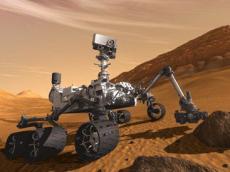|
|
TODAY.AZ / Weird / Interesting
Curiosity rover: after 'beautiful' test drive, NASA sets new sights
13 September 2012 [16:57] - TODAY.AZ
 Rover moved 4.5m and rotated through 120 degrees, latest part of extensive health check-up since it landed on 5 August.
Rover moved 4.5m and rotated through 120 degrees, latest part of extensive health check-up since it landed on 5 August.After two weeks of checking instruments, testing software and practising its rock-zapping skills, Curiosity the Mars rover has taken its first baby steps across the surface of the red planet.
Nasa announced on Wednesday that Curiosity had moved 4.5m and rotated through 120 degrees before reversing by 2.5m, a extra-terrestrial waltz that left the one-tonne vehicle some 6m from where it landed more than two weeks ago.
After a hair-raising entry on 5 August – when Curiosity was gingerly lowered to the surface by a module that fired rockets to keep the descent steady – extensive testing was needed to make sure all the caution involved in landing on Mars was not in vain.
Wednesday's voyage represented "a very big moment", said Pete Theisinger, Curiosity's project manager, who described himself as "ecstatic" at the progress.
"It couldn't be more important. We built a rover, so unless the rover roves we haven't accomplished anything."
Theisinger said the mission had been going "extremely well" so far, reporting "no anomalies or other issues", with the exception of suspected damage to one of two wind sensors on the rover's weather station, most likely caused by pebbles striking the device.
The site where Curiosity landed has been named Bradbury Landing, the team said, after science fiction writer Ray Bradbury. In his short story collection The Martian Chronicles, humans colonised Mars after fleeing a ravaged Earth. Bradbury, who died in June, would have turned 92 on Wednesday.
"This was not a difficult choice for the science team," said Michael Meyer, lead scientist of Nasa's Mars Exploration Program. "Many of us and millions of other readers were inspired in our lives by stories Ray Bradbury wrote to dream of the possibility of life on Mars."
The journey on Wednesday was described as "very beautiful" by lead driver Matt Heverly, who was behind the wheel for Curiosity's initial foray. "I'm pleased to report that today Curiosity had her first successful drive on Mars," he told the news conference in Pasadena, California, to whoops and cheers.
Heverly reported a "fully functioning" system on the rover. The conditions for driving had been kind too, the soil "firm, great for mobility". The key thing ascertained from the drive, Heverly said, was that the team had been able to "do one full revolution of the drive actuators", which power Curiosity's six wheels.
"We're very excited to have this milestone behind us. We can see that the system is performing very well."
The first few weeks on Mars are set aside for performing various tests on Curiosity to check its cameras and various scientific instruments. It is also an opportunity for engineers to get used to using Curiosity's robotic arm, which is 2m long and weighs in at 30kg – much bigger and trickier to maneuver than the arms on the previous Mars rovers, Spirit and Opportunity.
"They're not in any rush – this mission is meant to last for two Earth years," said Peter Grindrod, a planetary scientist at University College London, who has been watching every move of the mission. "The first few days are about: is everything in one piece, are the cameras working?"
The science experiments will start when the rover gets to its first place of interest, an area called Glenelg, about 400m away to the east of where it is now. Nasa scientists are also keen to analyse blast marks created on Mars's surface when the descent rockets moved away dust during the landing, revealing interesting-looking bedrock.
The rover has already fired its laser into the landing site and taken pictures and data, but Nasa has not yet revealed any of the measurements. "All the other rocks on the surface look like the Mars everyone knows from Viking through to Spirit," said Grindrod. "The ones that have been revealed [at the blast marks] look like they might be slightly lighter toned and might suggest a different composition. The most interesting thing is that these don't look like rocks that are just sat on the surface and have ended up there, either from thrown out from a meteorite impact or having been delivered by erosion. These things look like they might be in situ, where they formed."
Geologists can use in-situ rocks to ascertain a good idea of the history of that part of the planet – when it formed, for example, and in what conditions.
It will take Curiosity around three weeks or more to travel to Glenelg and, along the way, Nasa scientists will be watching everything the rover sees, in case they spot anything interesting on the journey. It could be a year before Curiosity gets to its main mission: Mount Sharp.
"There's two main things that make Mount Sharp interesting," Grindrod said. "It's five kilometres of layered rock, which are probably sediments. We're not sure how they are laid down but, on Earth, those layers are very good at revealing the environment in which they formed."
Another factor in choosing where to land Curiosity was the chemistry scientists saw from orbit. "Near the bottom there is evidence that water was around at some point in some form. If you go to the top, it's dry," said Grindrod.
URL: http://www.today.az/news/interesting/112361.html
 Print version
Print version
Views: 1721
Connect with us. Get latest news and updates.
See Also
- 19 February 2025 [22:20]
Visa and Mastercard can return to Russia, but with restrictions - 05 February 2025 [19:41]
Japan plans to negotiate with Trump to increase LNG imports from United States - 23 January 2025 [23:20]
Dubai once again named cleanest city in the world - 06 December 2024 [22:20]
Are scented candles harmful to health? - 23 November 2024 [14:11]
Magnitude 4.5 earthquake hits Azerbaijan's Lachin - 20 November 2024 [23:30]
Launch vehicle with prototype of Starship made its sixth test flight - 27 October 2024 [09:00]
Fuel prices expected to rise in Sweden - 24 October 2024 [19:14]
Turkiye strikes terror targets in Iraq and Syria - 23 October 2024 [23:46]
Kazakhstan supplied almost entire volume of oil planned for 2024 to Germany in 9 months - 23 October 2024 [22:17]
Taiwan reported passage of Chinese Navy aircraft carrier near island
Most Popular
 Azerbaijan and Ukraine discuss cooperation in healthcare industry and medicine production
Azerbaijan and Ukraine discuss cooperation in healthcare industry and medicine production
 Who stole the data on rare earths in Karabakh?
Who stole the data on rare earths in Karabakh?
 UNEC and BFSU deepen partnership in language and economics
UNEC and BFSU deepen partnership in language and economics
 Justice Ministry and SMBDA hold meeting with business associations
Justice Ministry and SMBDA hold meeting with business associations
 Academics are puzzled: it's time for Azerbaijani science to get down to business
Academics are puzzled: it's time for Azerbaijani science to get down to business
 President Ilham Aliyev addresses meeting dedicated to 80th anniversary of Azerbaijan National Academy of Sciences
President Ilham Aliyev addresses meeting dedicated to 80th anniversary of Azerbaijan National Academy of Sciences
 Brother and nephew of Armenian Catholicos arrested for obstructing election campaign
Brother and nephew of Armenian Catholicos arrested for obstructing election campaign
